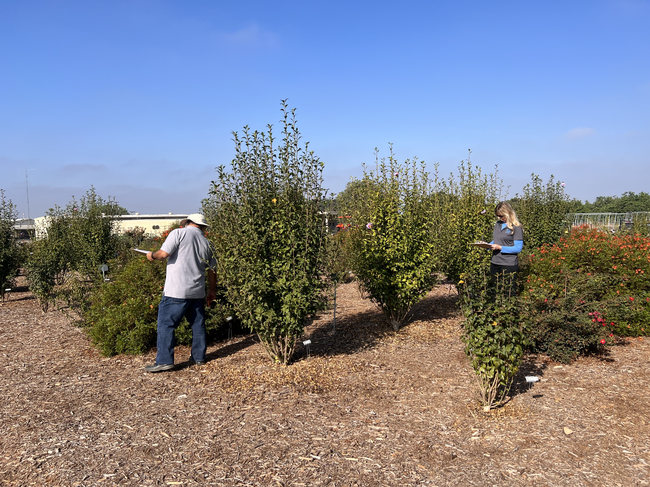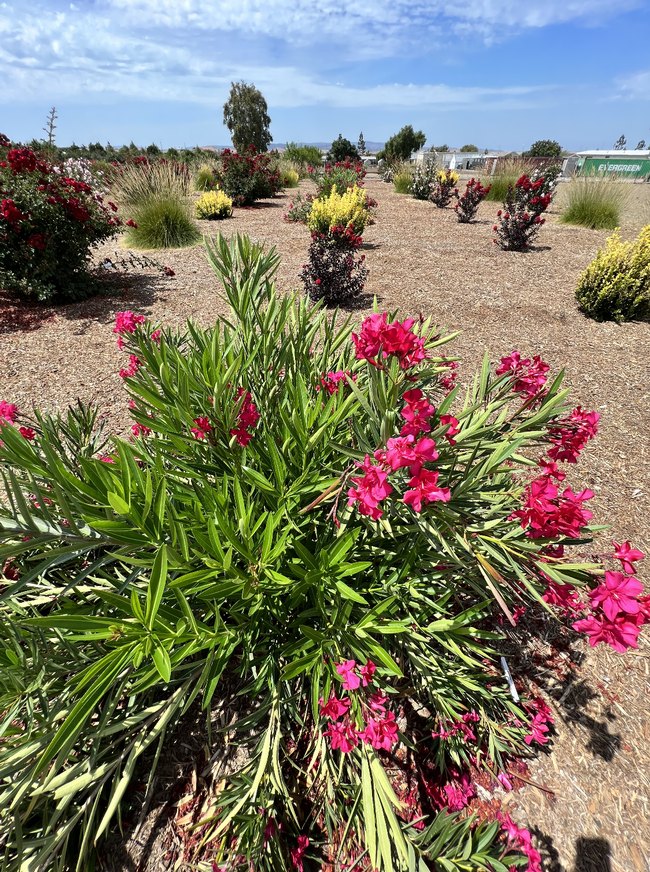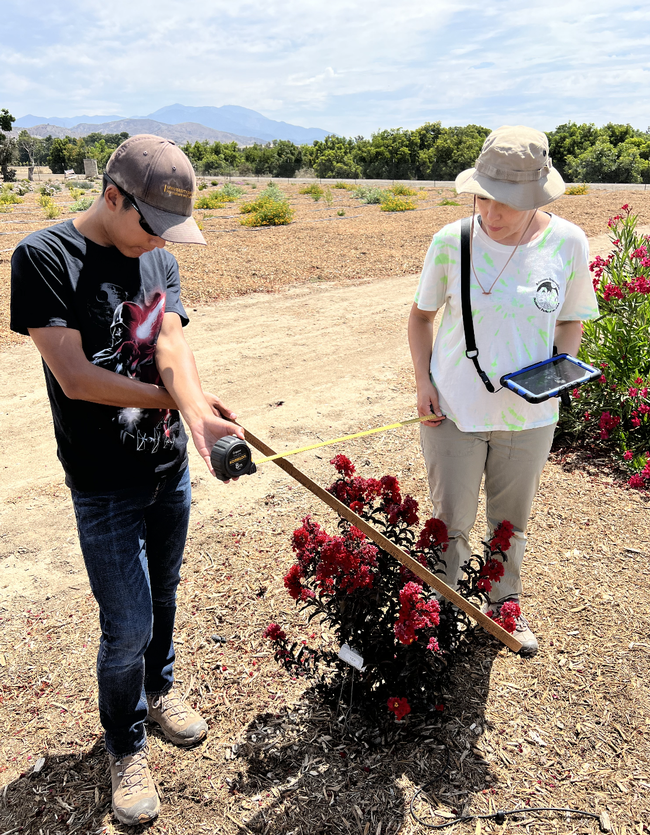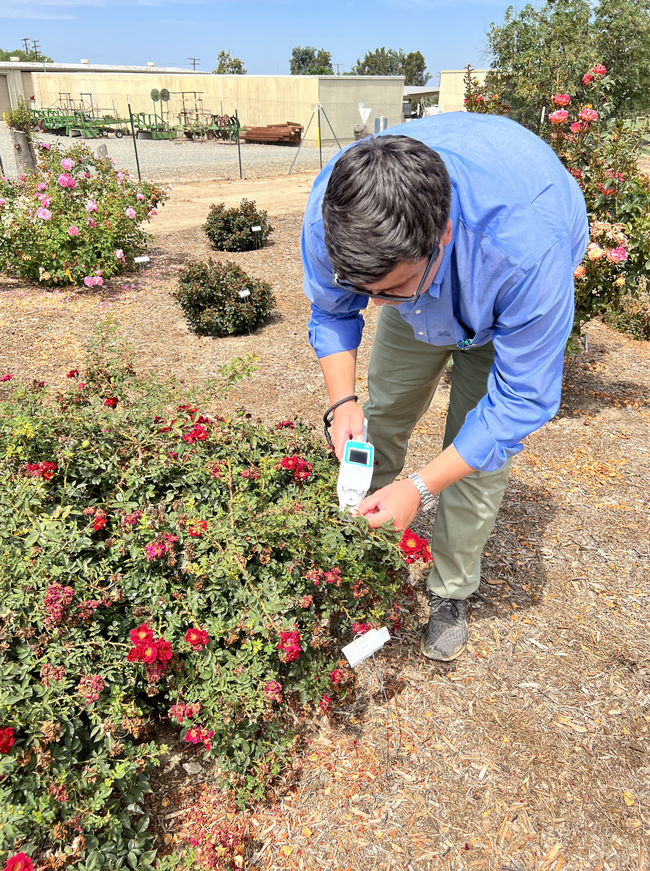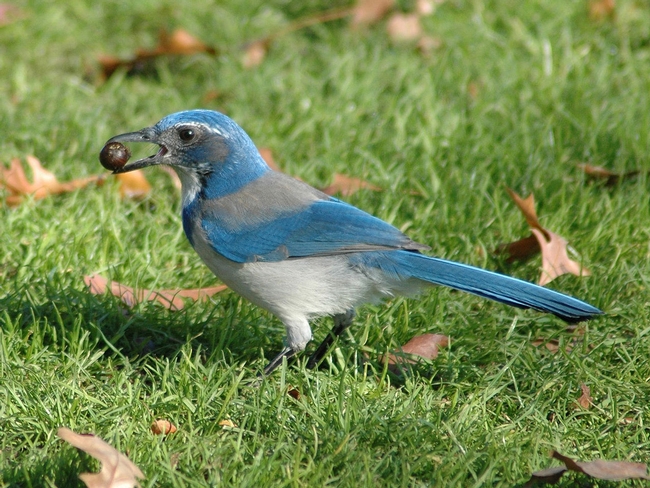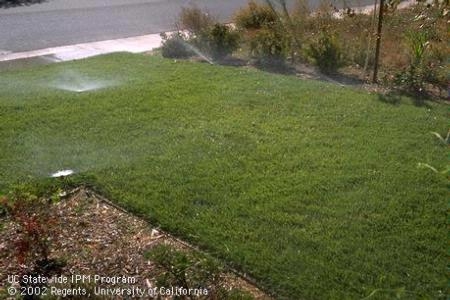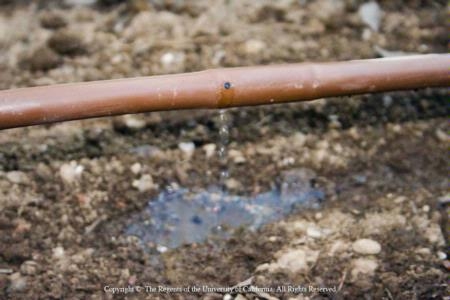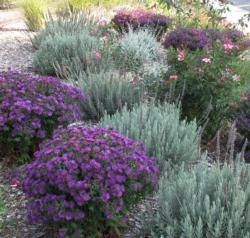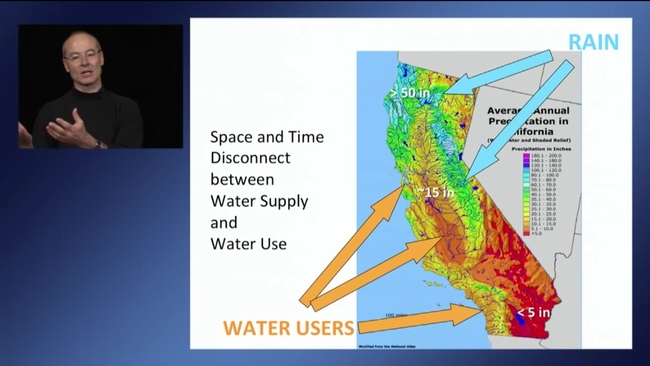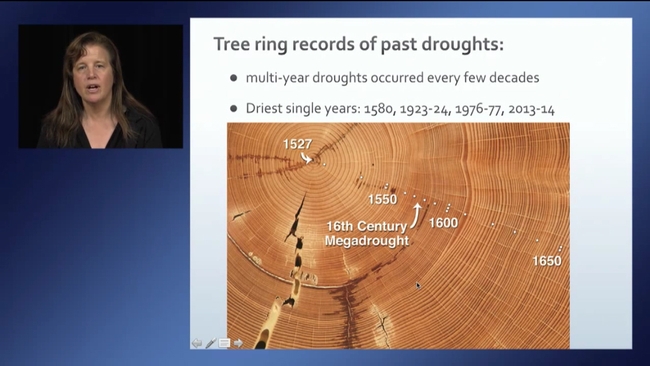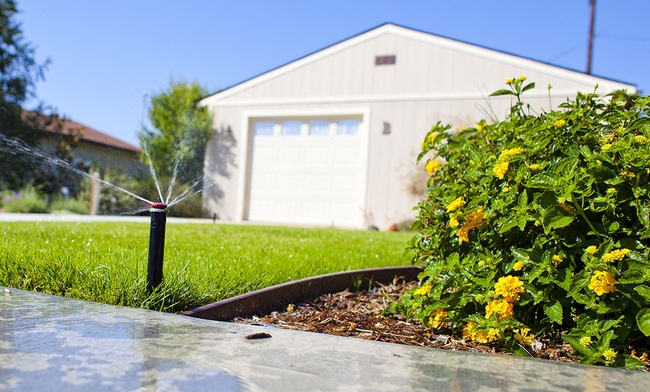Posts Tagged: Loren Oki
Your water-efficient landscape doesn’t have to be barren
UC climate-ready landscape trials identify low-water yet attractive plants
Good news: roses can be a part of your water-efficient landscape. Lorence Oki, UC Cooperative Extension environmental horticulture specialist in the UC Davis Department of Plant Sciences, identified rose cultivars that remain aesthetically pleasing with little water.
Oki is the principal investigator of the Climate-Ready Landscape Plants project, which may be the largest irrigation trial in the western U.S., and the UC Plant Landscape Irrigation Trials (UCLPIT), the California component of that project. These projects evaluate landscape plants under varying irrigation levels to determine their optimal performance in regions requiring supplemental summer water.
“There are some assumptions that pretty plants use a lot of water, like roses,” Oki said. “Everyone thinks they need a lot of water, but we've found some that don't, and they still look great. A water-efficient landscape doesn't need to look like a Central Valley oak-grassland in the summer. It can look really attractive.”
In 2021, Oki's team at UC Davis identified Lomandra confertifolia ssp. pallida "Pom Pom" Shorty and Rosa "Sprogreatpink" Brick House® Pink as two of the best low-water plants in the trial.
“The useful tip or information that is shared at the end of each trial is the selection and designation of plants as Blue Ribbon winners. These are the plants that looked good with an overall rating of 4 or higher throughout and were on the low (20%) water treatment,” said Natalie Levy, associate specialist for water resources, who manages the project at the UC ANR South Coast Research and Extension Center.
How plants earn a blue ribbon
Each trial year, the selection of new plants is based on research recommendations and donated submissions from the nursery industry. The landscape plants are trialed in full sun or 50% shade cover.
Irrigation treatments are based on the rate of evaporation and plant transpiration (evapotranspiration) measured through a local California Irrigation Management Information System (CIMIS) weather station that provides a reference evapotranspiration (ETo) rate.
Three levels of irrigation are provided to the plants equal to 20%, 50%, and 80% of ETo. The volume of water applied is the same at each irrigation based on soil characteristics, but the interval between applications varies with weather and the treatment. Using this method, irrigations for the 20% treatment are less frequent than the 80% treatment.
“The 20% treatment during the 2022 trial was irrigated an average of once per month while the 80% treatment was irrigated weekly,” explained Levy.
During the deficit irrigation trial, monthly height and width measurements are taken to determine the plant growth index. Monthly qualitative aesthetic ratings on a scale of 1 to 5 are determined for foliage appearance, flowering abundance, pest tolerance, disease resistance, vigor and overall appearance.
A second round of flowering abundance and overall appearance measurements are also taken to capture more of the blooming period. For example, UCLPIT identified in the 2020 trial at South Coast REC that the "Apricot Drift" rose had a mean overall appearance score of 3.5 out of 5, deeming it “acceptable to very nice” and a low water use plant within the Water Use Classification of Landscape Species or WUCOLS guide.
Project expands options for landscape planting
“(WUCOLS) only has 3,500 plants in it. There are guesses that there are close to 10,000 cultivars in urban landscapes in California, if not more,” said Oki. “WUCOLS also didn't have numerical ratings. Instead, you'll see verbal ratings like ‘low water use' or ‘high water use.'”
The UCLPIT project has not only developed numerical recommendations for irrigation, but it has also added new landscape plants that are compliant with California's Model Water Efficient Landscape Ordinance. In fact, UCLPIT's data is one of the few sources that can be used to supplement WUCOLS.
Geographic diversity of trial sites adds to knowledge base
In addition to UC Davis and South Coast REC in Irvine, the trials have expanded beyond California as the Climate-Ready Landscape Plants project and is in progress at Oregon State University, University of Washington, University of Arizona and Utah State University thanks to a USDA/CDFA grant awarded in 2020.
Lloyd Nackley, associate professor of nursery production and greenhouse management at Oregon State University, is the principal investigator of the trial in the Portland metro area, which is entering its third year.
“People know that there are drought tolerant plants, but there are many. We're trying to highlight lesser known or newer varieties. And even though the trial is three years, most gardeners would hope that their garden lasts longer than that,” said Nackley.
One of the observations that Nackley recalls is of the Hibiscus Purple Pillar plant. Unlike the trial at South Coast, the Purple Pillar did not perform well in Oregon in the spring.
“It wasn't until August that we saw the plant bloom and begin to look like what we saw from South Coast in April,” Nackley said.
Ursula Schuch, horticulture professor and principal investigator of the trial taking place at the University of Arizona, was also surprised at the range of performance among different plant types and the effects of irrigation, heat and temperature.
“This research will reassure green industry professionals that they can stretch their water budget to successfully cultivate more plants, watering them according to their needs instead of irrigating every plant according to the highest water-using plants,” said Schuch.
Although research is only conducted in the West, the hope is that there will be trials in other regions of U.S.
Doing so would yield comprehensive information about the plants and their performance in different climates. As extreme weather events persist in the U.S., disease pressure and risks do too. Trials throughout the country would provide location-specific data regarding disease susceptibility.
To learn more about the UCLPIT research project, visit https://ucanr.edu/sites/UCLPIT/
Adapting to drought by removing urban landscapes has unintended impacts
Removing landscaping in urban areas to adapt to the California drought carries a gamut of potential repercussions on wildlife and the environment, reported LA Weekly. Two of Gov. Brown's water conservation rules - withholding water from grassy road medians and encouraging residents to remove their lawns - are taking an unexpected toll.
The subject was raised recently by two University of California Agriculture and Natural Resources (UC ANR) experts in a position paper they published on their website, the story said. Don Hodel, UC ANR Cooperative Extension advisor in LA County, and Dennis Pittenger, UC ANR Cooperative Extension area environmental horticulturist at UC Riverside, said landscapes and turf offer tremendous benefits to residents, communities and the environment.
"Nobody thought this out," Hodel said.
The LA Weekly article also quoted Loren Oki, the UC ANR Cooperative Extension specialist for landscape horticulture based at UC Davis. Among the obvious problems created by California's turf-removal program, Oki said, is "encouraging people to plant during the heat of the summer, which is the worst time" for new plants to survive in the ground. He predicts many of the low-water plants will not survive the late-summer heat.
Another UC Davis scientist, biochemistry professor William Horwath, raised the potential for turf removal to kill the "decomposition community" that lives in soil.
When cities and homeowners remove vegetation from land, that diminishes the diversity of the soil biology, especially the larger fauna such as worms, which feed off of the droppings of leaves and other materials from plants.
"If you are not growing anything, just gravel or mulch, you'll be losing a lot of worms, and you will at the same time be losing a lot of carbon from under the soil back into the atmosphere," Horwath said.
Oki was one of the authors of a recent post on the UC ANR California Institute for Water Resources blog, The Confluence, that provides practical, well-thought-out advice on drought-tolerant landscaping in California.
"A variety of options exist for gardeners implementing landscaping changes," the article says. "Trading in your turf for concrete, rock, or artificial turf are options. However, none of these selections promote healthy soils and other ecosystem services. In fact, all of these options can be problematic because they create a heat island effect and may have water infiltration or runoff issues."
The story details seven strategies for conserving water while maintaining a living landscape.
6 ways to reduce water use without killing your garden
For homeowners, there are six key things to do to conserve landscape water, says Karrie Reid, UC ANR Cooperative Extension advisor, in San Joaquin County. Reid gives the following six tips:
- Tune up your irrigation system right away. When water is efficiently and accurately applied, less water is needed to keep plants healthy. Spray heads can get knocked out of alignment and end up spraying the sidewalk, street or driveway and running to the gutter. Check all spray heads to ensure they are hitting the target and twist those that aren't back into place. Some heads have adjustable angles of spray, which can be fixed with a tool available at a hardware store. Look for cocked heads, which spray water up into the air, and sprays blocked by grass or those that have sunk below grade. Make sure all spray heads are made by the same manufacturer and are from the same line so they deliver water at the same rate, otherwise they'll leave dry spots. Low-volume spray heads or rotators deliver water more efficiently.
- Water the whole root zone. On allowed watering days, irrigate until the water reaches 12 inches deep for grass, 12 to 18 inches for shrub and perennials, and 12 to 24 inches for trees. This provides a greater reservoir of water for the plants to draw from, and many will be able to get by on weekly, twice-monthly or monthly irrigation if they are conditioned to send their roots deep. To check the watering depth, use a soil probe or push a long screwdriver into the ground. The depth it reaches easily indicates how deeply the water has infiltrated.
- Avoid wasting water to runoff. If water runs off before the watering cycle finishes, split the cycle time. Set the timer to water in two, three or even four cycles at least an hour apart to allow the water to soak in. To ensure water isn't flowing below the root zone, check the watering depth after each cycle.
An irrigation scheduling worksheet created by Loren Oki, UC ANR Cooperative Extension specialist in the Department of Plant Sciences at UC Davis, and Darren Haver, UC ANR Cooperative Extension advisor in Orange County, helps fine tune irrigation timing. The worksheet is available for free online at the Center for Urban Horticulture website http://www.ccuh.ucdavis.edu.
- Switch to inline drip tubing for beds. Drip irrigation applies water where it is needed with less loss to the air. Be sure to lay tubing so water reaches plants' entire root zone.
- MULCH, MULCH, MULCH. Adding 3 or 4 inches of organic material such as wood chips, shredded bark or bark nuggets will improve soil health while retaining water and lowering stress on your plants. Place mulch away from the street curb to prevent heavy rains from washing it into the storm drains.
- Replace water-needy plants with low water users in the fall. All plants use a lot of water to get established when they are planted in the spring and summer, and for about a year after. Trees may need extra water for several years until their roots have grown well into the surrounding soil. By waiting until temperatures cool in the fall to plant, it will be easier to abide by the water restrictions. It's also important to use hydrozoning, which means placing plants with the same water needs on the same valve. Otherwise, irrigating to the thirstiest plants on that station will give other plants more water than they need.
Too wet outside to work? Watch a drought video
Rain has begun falling, but California continues to operate under severe water scarcity from low precipitation over the past three years.
“California will need about 150 percent of normal rainfall this winter to end the drought,” said Doug Parker, director of UC California Institute of Water Resources. “Although the rains have come, we can't afford to let our attention drift away from carefully managing our water supply.”
The UC California Institute of Water Resources, with support from the California Department of Water Resources, has recorded presentations by scientists in the UC system and other organizations on a variety of topics related to water management and drought. “Insights: Water and Drought Online Seminar Series” is accessible by computer or mobile device.
The online seminars enable UC Cooperative Extension and the other scientists to share their knowledge with a larger audience than those who can attend meetings in person, said Daniele Zaccaria, UC Cooperative Extension specialist in agricultural water management in the Department of Land, Air and Water Resources at UC Davis.
“Farmers, landscape professionals, land managers, irrigation consultants, resource managers from water districts and others can view the half-hour video presentations on YouTube whenever it is convenient for them, obtaining science-based information that stems from applied research conducted by several scientists over the last 10 to 15 years,” said Zaccaria, who coordinates the speaker series.
Topics include drought impacts on natural resources, drought preparedness, water management in urban landscapes during a drought and crop management with limited water.
Currently 39 videos addressing drought and water management in different settings are available, and more talks will be added in the coming months. The videos are also being used by Cooperative Extension in other states and have been viewed hundreds of times. “Groundwater and surface water interactions under water shortage,” by Thomas Harter, UC Cooperative Extension specialist in the Department of Land, Air and Water Resources at UC Davis, has been viewed nearly 1,400 times and “Climate change and paleoclimatology: 2013/2014 in perspective” by Lynn Ingram, professor in the Department of Earth and Planetary Science at UC Berkeley, has been more than 800 times.
The following titles have recently been added:
Water resources management in the Pajaro Valley, California
Brian Lockwood, senior hydrologist, Pajaro Valley Water Management Agency
Managing corn under California's drought conditions
Mark Lundy, UC Cooperative Extension advisor in Sutter, Yuba and Glenn counties
Droughts, climate change, and dams: Reconciling a future for California's native inland fishes
Peter Moyle, professor in the Department of Wildlife, Fish & Conservation Biology at UC Davis
Managing landscapes on limited water
Loren Oki, UC Cooperative Extension specialist in the Department of Plant Sciences at UC Davis
Drought - An insidious stress on wildlife
Greg Giusti, UC Cooperative Extension advisor, forests and wildland ecology in Mendocino County
Agricultural water management practices under limited water supply: Lessons from recent droughts
James E. Ayars, agricultural engineer, USDA-ARS
Soil moisture monitoring and utilization during a drought
Dan Munk, UC Cooperative Extension advisor, irrigation, soils and cotton in Fresno County
Land subsidence along the Delta-Mendota Canal and neighboring areas
Michelle Sneed, California Water Science Center, US Geological Survey
How to save water and beautify your landscape ... the sustainable way
Janet Hartin, UC Cooperative Extension advisor, environmental horticulture in San Bernardino and Los Angeles counties
Efficient citrus irrigation
Blake Sanden, UC Cooperative Extension advisor, irrigation and soils in Kern County
Using agroecological practices to enhance the resilience of organic farms to drought
Miguel A. Altieri, professor in the Department of Environmental Science, Policy and Management, UC Berkeley
The drought videos are available at http://ucanr.edu/insights and https://www.youtube.com/UCANR.
Conserve water with proven landscape irrigation strategies
Turning off your sprinklers after rain falls is the first step to take this spring to conserve water, but there is much more to do in the coming months, according to Chuck Ingels, UC Cooperative Extension advisor in Sacramento County.
“Landscape irrigation represents well over half the water use in the average household,” Ingels said. “There are many proven ways to reduce high summer landscape water usage and these strategies will be especially critical this year due to the unprecedented drought in California.”
An expert in environmental horticulture, Ingels has maintained research and education programs for the University of California for 22 years on water conservation, deficit irrigation, sustainable landscaping and alternative turfgrass species. He also coordinates the UC Master Gardener program in Sacramento County.
In the spring, when the air temperature is in the 70s in much of California, lawns need about one-half to three-quarters of an inch of water per week, Ingels said. In the heat of the summer, water needs increase to about 1 inch to 1.5 inches per week. Knowing how much water to apply is half the battle. The other half is figuring out how much water is delivered by your irrigation system.
To calculate your home sprinklers' output, Ingels recommends conducting a catch can test. Place small cans with straight sides, like pet food or tuna cans, on the lawn in several places and run the sprinklers for 20 minutes. Use a ruler to measure the water in each can and determine the average. Multiply by three to get an hourly irrigation rate. Detailed information about various lawn species' water needs in different parts of California is outlined in the free UC Division of Agriculture and Natural Resources online publication Lawn Watering Guide for California. The document gives watering guidelines for warm season and cool season grass species growing in 10 climate regions in the state.
Loren Oki, UCCE specialist in the Department of Plant Sciences at UC Davis, a landscape horticulture expert, has conducted research on a wasteful but common residential lawn-watering problem in California: runoff.
“Much of the water that is applied to lawns runs directly into the gutters,” Oki said. “Not only is this wasted water, but we have found that the runoff carries pollutants – including pesticides and fertilizers – into the gutters and, eventually, into waterways. The problem is that typical sprinkler systems apply water faster than the soil can absorb it, which leads to runoff.”
To prevent runoff, use “cycle and soak,” a setting available on many irrigation controllers.
“This means the sprinklers come on for short periods with breaks in between to allow water to move into the soil,” Ingels said. “You'll still want to apply the full amount of water each of the days you're allowed to water, but you'll need a few hours between waterings to be sure it all soaks in.”
Sprinklers that spray a mist over lawns are another cause of water waste. Much of the water evaporates before it reaches the ground.
“You can save water by converting to rotary nozzles,” Ingels said. “The nozzles shoot out streams of water that provide very uniform watering. They have been shown to improve efficiency by 10 to 20 percent.”
In landscape borders, homeowners can save water by using a drip irrigation system. Drip irrigation will target water directly where the plants are growing, so no water is wasted wetting ground in areas where plant roots cannot reach. For optimal efficiency, the system must be carefully monitored throughout the growing season.
“Drip can be a great water saver, but it can also waste water if the system is poorly designed, if it's allowed to run too long, or if lines are accidentally cut with a shovel or other tool,” Ingels said.
Another water-saving strategy is preventing evaporation at the soil surface. Ingels suggests topping the soil with bark, wood chip, straw or other mulch.
“Bark and wood chips provide a long-lasting barrier to water evaporation from the soil,” he said. “Straw mulch works well in vegetable gardens. It saves water, keeps down weeds, and helps cool plant roots in the heat of the summer.”
Whatever irrigation system is used, Ingels said it is essential to check soil periodically throughout the year to determine how wet or dry it is and adjust the irrigation schedule as needed. The easiest way to check soil moisture, he said, is using a screwdriver.
“Just push a screwdriver down into the soil,” he said. “When the soil is moist, it will go all the way down. If the soil is moist only a few inches, the screwdriver will only go down that far.”
A more expensive soil sample tool, which pulls out a soil core, can be purchased at some nurseries and irrigation supply stores. Soil sampling provides more information about the soil, which is useful for making irrigation decisions.
UC Cooperative Extension and its Master Gardener program have abundant information on water conservation in the landscape:
- UC Guide to Healthy Lawns http://www.ipm.ucdavis.edu/TOOLS/TURF/
- Water use on Turfgrass and Landscape Plant Materials http://ucanr.edu/sites/UrbanHort/Water_Use_of_Turfgrass_and_Landscape_Plant_Materials/
- Drought: Gardening Tips http://cagardenweb.ucanr.edu/Drought_/Drought_Gardening_Tips_/
- Drought: Irrigation Tips http://cagardenweb.ucanr.edu/Drought_/Drought_Irrigation_Tips_/
- California Master Gardener programs (by county) http://camastergardeners.ucanr.edu/California_Counties_MG_Websites/
University of California Division of Agriculture and Natural Resources is celebrating 100 years of UC Cooperative Extension researchers and educators drawing on local expertise to conduct agricultural, environmental, economic, youth development and nutrition research that helps California thrive.
Media contacts:
- Chuck Ingels, UCCE advisor, Sacramento County, (916) 875-6527, cell (916) 835-7458, caingels@ucanr.edu
- Loren Oki, UCCE specialist, Department of Plant Sciences, UC Davis, (530) 754-4135, lroki@ucdavis.edu

